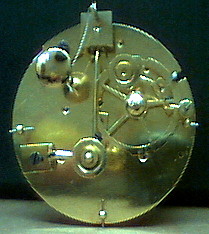This kind of movement can be found on a great number of clocks all around
Europe, especially in France (of course) and Italy.
It is employed in the great majority of pendulum clocks made in the 1700s
and the 1800s. Its round shape and the few variations adopted in its construction
make it easily distinguishable.
Here is how it appears to a first look inside the case: the bell has been removed to show the great five spoke wheel called "locking plate", common to about 90% of the production

1) Hands must be moved clockwise only. On every hour and half you have to wait for the strikework to complete the whole number of blows. It is indeed possible to turn hands backward with a limited movement. Using extreme care it is easy to feel the point where the minute hand starts to oppose to this movement. Do not go further.
2) This kind of movement must be overhauled at least every four years. More often when mounted in a case that leaves it exposed to the dust. It is absolutely wrong to wait until the clock stops by itself. In this case rather serious damages would surely produce (wearing of pivots and pinions). The cost of overhauling will greatly increase and the life of the movement will be shorter.
3) In case the clock must be transported it is necessary to remove the pendulum from the movement. It is a rather simple operation: the bell is removed by unscrewing its nut and the pendulum is gently unhooked. This is not necessary when simply moving the clock to clear the surface beneath it.
4) Do not to try to clean up the case (especially if gilded). It is only safe to remove dust with a soft cloth. Aggressive or abrasive cleaning products could permanently damage it.
It is common to believe that the "Pendule de Paris" can run for eight days on a single wind, like the majority of quality pendulum clocks.
Indeed, it should run for fifteen days.
There is a simple reason for this misunderstanding : the mainsprings are 80 to 200 years old.
They have lost in strength and therefore they can't keep the clock running in the last few days, when they are almost completely unwound.
They succeed well when they are completely or nearly completely loaded. For a clockmaker it is easy to advise the owner to wind the clock every eight days rather than every fifteen days. It will be also easier for the owner to remember a thing to be done weekly rather than every two weeks.
The solution to this problem appears to be very simple: to replace the mainsprings. Unfortunately today's construction standard is different from those used in the 19th and 18th Century. Given the barrel diameter and height the spring is thicker than in the past.
This brings two considerations:
1) Being the mainspring thicker, it requires more space inside the barrel and so a shorter mainspring must be mounted, thus decreasing the wind duration.
2) The greater thickness corresponds to a much greater increase of the force of the mainspring: should it break it would seriously damage the movement, sometimes breaking pivots, barrel wheel teeth and first pinion leafs.
A mainspring with the same thickness of the original but shorter than it must be used.
The wind duration will not reach 15 days but the clock won't be destroyed by its possible breakage.
During an accurate overhaul mainsprings can be made to exact size by hardening and tempering an appropriate steel tape. It is a hardly adopted solution because of its high cost. It seems that the owner of an antique clock does not care too much of how long it will run on a single wind. Sometimes the original broken mainspring has to be replaced and since the clock loses an original part it is not bad practice to use a slightly shorter one, from the technical and historical point of view..
An annoying problem of this type of movement is the possibility that the hands mark an hour that differs from the blows struck by the clock.
This may happen after setting hands to time, if one does not wait that all the blows are played when passing on hours and halves.
It may also happen when the unwound clock stops: sometimes the strike gear train cannot remain synchronized with the time marked by the hands.
There are different solutions to this matter; this is probably the easiest, making not necessary to touch the movement:
1) Bring the minute hand near a half of your choice, without passing over it. Click on the image to see the animation:
2) Bring it back slowly, till the clock strikes. Click on the image to see the animation
By repeating this action, hours and half are played in succession while the hands in their limited forward-backwards movement remain always at the same place. The action must be terminated when the clock will have played the exact number of strikes which corresponds to the last hour passed by the hands, in our animation 12 o'clock.